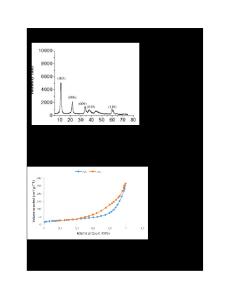Mechanical Properties of Superhard Nanocomposites with High Thermal Stability
- PDF / 80,720 Bytes
- 6 Pages / 595 x 842 pts (A4) Page_size
- 115 Downloads / 427 Views
Q2.2.1
Mechanical Properties of Superhard Nanocomposites with High Thermal Stability Stan Veprek1, *) and Ali S. Argon2 1
Institute for Chemistry of Inorganic Materials, Technical University Munich, Garching b. Munich, Germany 2 Department of Mechanical Engineering, Massachusetts Institute of Technology, Cambridge, Massachusetts, Abstract Superhard nanocomposites, nc-MnN/a-XxNy (M = Ti, W, V, Zr, (Al1-xTix)N; X = Si, B) with hardness of 40-100 GPa are prepared by plasma CVD or PVD under a sufficiently high nitrogen activity and deposition temperature that allow the formation of a stable nanostructure by self-organization upon strong thermodynamically driven, spinodal phase segregation. These nanocomposites display an extraordinary combination of a high hardness, high elastic recovery, high resistance against brittle fracture and tensile strength of 5 to 40 GPa approaching the ideal strength of flaw-free materials. These properties can be understood in terms of conventional fracture physics scaled appropriately down to crystallite sizes of few nm. The interfacial monolayer of Si3N4 or BN with strong bonding to the nanocrystallites and high structural flexibility avoids grain boundary sliding. With increasing thickness of this interface the hardness decreases, possibly due to an increase of this “liquid-like” component in which plastic transformation can be triggered. *) Corresponding author: Phone: ..49-89-2891 3624; Fax: ..49-89-2891 3626 E-mail: [email protected] Introduction Superhard (Vickers hardness HV ≥ 40 GPa) materials can be divided in three different categories [1]: a) Intrinsically superhard materials that attain their strength from strong, covalent interatomic bond with a short bond distance include diamond (HV = 70-90 GPa) and cubic boron nitride, c-BN (HV≈ 48 GPa), b) thin coatings deposited by plasma PVD under energetic ion bombardment and c) nano-structured materials, such as heterostructures and nanocomposites. Hardness enhancement up to 40–100 GPa due to the energetic ion bombardment has been reported in a number of coatings of transition metal nitrides, carbides and borides (for a summary of the literature see e.g. [1-4] and also the so called “nanocomposites” consisting of a hard transition metal nitride and a ductile metal (e.g. ZrN/Ni, ZrN/Cu, CrxN/Ni etc. [5]). The mechanism of that hardening is a complex, synergistic effect of a decreasing crystallite size, build-up of a compressive stress, densification of grain boundaries and formation of point (and in some cases also extended) defects due to displacement damage (see e.g. [6]). A disadvantage of that hardening is a low thermal stability because the hardness enhancement vanishes upon annealing to ≥ 400 °C (e.g. [1, 2, 4, 7]). This applies also to the ZrN/Ni, ZrN/Cu, CrxN/Ni etc. “nanocomposites” where the hardness enhancement is solely due to the ion bombardment [4, 8]. In contrast, the superhard nanocomposites, such as ncMenN/a-Si3N4 (Me= Ti, W, V, (Al1-xTix)N, …), nc-TiN/a-BN, nc-TiN/a-BN/a-TiB2 and others (nc- and a- means nanocrystallin
Data Loading...











